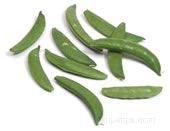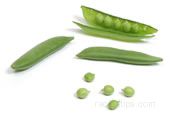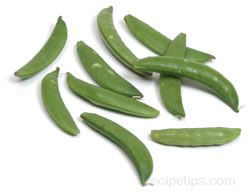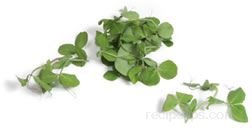|
Pea Preparation | Pea Cooking Tips
| Peas |
|
  
Varieties of small round legumes that are typically classified as fresh, field or pod peas. The fresh pea is a small, round green vegetable, which is grown in a pod and is generally harvested in the early summer. The fresh pea is grown to be removed from the pod and eaten raw or cooked. Field peas, unlike fresh peas, are grown to be dried and then split or used whole for use in purées, soups and food dishes requiring thickening. Pod peas, such as the snow or sugar snap pea are grown to be eaten with both the pod and the pea together, either raw as a fresh pea or cooked. |
| Uses:
Peas can be eaten raw or cooked, which sweetens them slightly. Peas are eaten on their own as a vegetable dish or added to other vegetables, salads, stir-fries, savory dishes, soups, and stews. Peas can be used as a substitution in most recipes that call for green beans. |
| At Their Best:
Fresh peas may be found in the markets in the spring, but may be hard to find because they do not retain their freshness for very long. Snow peas are available throughout the year in supermarkets, produce markets, and Oriental markets. Sugar snap peas are available spring to fall.
Frozen, canned, and dried peas are available year-round. |
| How to Buy:
Fresh peas: Select peas with smooth, bright green pods that contain a good number of seeds that are small in size.
Pod peas: Select peas with bright green, crisp pods that are not damaged, soft or shriveled. Snow peas should have flat pods with tiny seeds that are barely visible. Sugar snap peas should have mature seeds that are large enough to make the pod appear bumpy. |
| Storage:
Peas are best eaten as soon as possible after they are picked. To store, place them in a container that is not airtight or place them in a perforated plastic bag. The can be refrigerated for 3 or 4 days. The longer they are refrigerated the less sweet they will be. Do not leave peas out at room temperature.
Place whole or split dried peas in an airtight, glass container and store in a cool, dry dark place. |
| Varieties: |
|
Fresh Peas
 |
The fresh pea is a small, round green vegetable, which is grown in a pod and is generally harvested in the early summer. Also known by other names such as sweet pea, green pea, garden pea, or English pea, the fresh pea is grown to be removed from the pod and eaten raw or used as an ingredient to be added to salads, soups, stews, casseroles, and other dishes. Fresh peas are available as a raw podded pea, canned as a shelled pea and frozen. |
Field Peas
|
Field peas, unlike fresh peas, are grown to be dried and then split or used whole for use in purées, soups and food dishes requiring thickening. Varieties of the field pea include the green and yellow pea (either split or whole), the chickpea, and the black-eyed pea. |
|
Pod Peas

Snow Peas

Sugar Snap Peas |
Pod peas, such as the snow or sugar snap pea are grown to be eaten with both the pod and the pea together, either raw as a fresh pea or cooked. Pod peas are often served in salads, stir-fries, and Asian food dishes.
Snow Peas
Flat, edible, pea pods that contain tiny peas. The thin crisp pods from this vegetable are a bright green, turning a rich dark green when cooked. They do not require shelling but the string may need to be removed from the larger pods and the tips are generally snapped off. They are commonly used as an ingredient in Asian dishes.
Sugar Snap Peas
A flavorful vegetable that is a cross between snow peas and garden peas. The peas are eaten in the pods and do not require shelling. As the peas mature, the pod increases in size creating an irregular or lumpy appearance to the pod. Sugar snap peas have a crispy texture and a sweet flavor. They should be served raw or only cooked for a short time for them to retain their crispness. Also called "sugar peas." |
|
Snow Pea Sprouts
|
The firm but tender new shoots of the snow pea plant. The sprouts are eaten raw, steamed, stir-fried or added to soups. The sprouts will also produce succulent stems and leaves, known as snow pea leaves, which can be steamed or used in stir-frying. |
| Snow Pea Leaves |
The tender leaves and trendils, produced by the snow pea sprouts, which can be eaten raw, steamed or used in stir-fries. |
Pea Shoots
 |
The delicate spiraling vines (shoots) and uppermost leaves of a young pea plant whose flavor is a cross between peas and spinach with a hint of watercress. Although Pea Shoots can be harvested from any variety of pea, the most commonly harvested are those from immature snow peas. They are added to stir-fries just before serving, sautéed as you would other greens in oil and seasonings, or they are served as fresh ingredients in salads. The Cantonese name for pea shoots is "dau miu". Pea shoots are available in Chinese markets in the spring. Place in a plastic bag and store in the refrigerator for one or two days. It is best when used the same day of purchasing. Do not wash until just before using. |
Pea Preparation
The different varieties of peas each require a little different preparation. They all require just a simple but thorough rinsing before any preparation begins.
Fresh Peas
Once the peas have been rinsed, snap the top of the pod off and pull down to remove the string from the seam. Then simply split the pod open and use your thumb to pop out the peas. The peas should not need to be rinsed. It is suggested by some that the peas be removed from the pods as soon as possible and that only the shelled peas be store in the refrigerator if they are not to be eaten immediately.
Pod Peas
Snow peas and sugar snap peas are meant to be eaten with the pod. After rinsing, snap off the stem end and remove the string from the inner side.
Dried Field Peas
Dried peas must be soaked before they can be cooked. Before soaking, check through the peas and remove any dirt or debris they may contain. Whole dried peas must be soaked for 6 to 8 hours before cooking. Split peas do not require soaking before cooking but they can be soaked for several hours to help reduce the amount of foaming that occurs during the cooking process. To soak, place peas in a bowl and cover with cold water. Be sure that the bowl is large enough to accommodate the swelling of the peas. After soaking, pour the water off the peas and rinse the peas with cold, clean water. Cook as instructed by the recipe.
Pea Cooking Tips
- Steam: Place in steamer over boiling water until they are tender.
- To Boil: Bring salted water to a boil, drop in peas and simmer for 4-10 minutes for Green peas and 1-3 minutes for Snow and Sugar peas.
- Boiling Dried Peas: Add 4 cups of water to 1 cup of peas, bring peas to a boil, reduce to a simmer, and cover. Cook until tender, approximately one hour. Skim off foam when necessary.
- Leave peas in pods and add to stir fry.
- Add a mint sprig to water when steaming or boiling for added flavor.
- Add cold peas to lettuce salad.
|

